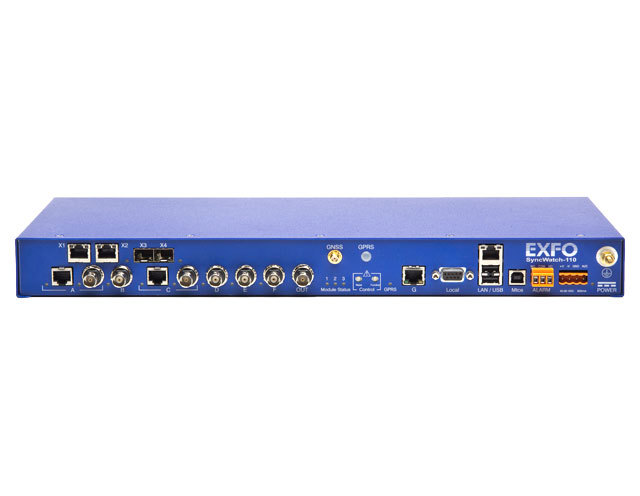
Caractéristiques principales

Applications
Description
Comprehensive Synchronization Testing
The SyncWatch-110 Synchronization Testing Unit is designed for accurate measurement and monitoring of a wide range of synchronization technologies, covering the complete network lifecycle. Its flexible architecture, which can be adapted to multiple deployment scenarios, makes the SyncWatch-110 a highly versatile, all-in-one solution. SyncWatch-110 is purpose-built for qualifying and monitoring next-generation networks that use Precision Time Protocol 1588v2 or SyncE technologies, as well as traditional TDM and frequency synchronization, making it the tool of choice for service providers and network solution vendors.
The SyncWatch-110 unit supports measurements in both frequency and packet domains, which includes TIE, MTIE and TDEV metrics. SyncWatch-110 can utilize external frequency references or internal GPS engines—with or without a rubidium oscillator. The SyncWatch-110 unit also supports the analysis of frequency output signal from a precision-time-protocol client module; the packet measurement engine is capable of analyzing the IEEE 1588 V2 timing packets as well as reporting on different packet metrics.
What’s more, SyncWatch-110 supports three different modes of operation (Stand-Alone, USB and Managed) for testing adapted to the service-provider’s applications, while addressing the entire network lifecycle.
SyncWatch Stand-Alone
The SyncWatch Stand-Alone mode combines a single SyncWatch-110 unit in conjunction with the synchronization monitoring and measurement software suite, running on a laptop or desktop computer. With its compact and portable form factor, the SyncWatch-110 unit, set in SyncWatch Stand-Alone mode, can be deployed as a bench tester in a system-proofing environment, or it can even be deployed in the field as an installation/commissioning and troubleshooting tool. Stand-Alone mode provides real-time synchronization, data analysis and live reporting of results for immediate analysis.
SyncWatch USB
In SyncWatch USB mode, the SyncWatch-110 unit can simply be used in conjunction with a dedicated USB key. SyncWatch USB mode enables users to configure a unit by simply inserting the USB device. Once a measurement has been taken, the collected data is then directed to the SyncWatch USB key for data post-processing and analysis. Operation in SyncWatch USB mode is user-friendly and simple to use, making it the ideal mode for field personnel with less familiarity in synchronization testing.
SyncWatch Managed
SyncWatch Managed mode is a highly scalable solution for measuring and managing synchronization quality across a service provider’s infrastructure—right to the edge of the network. Based on a server/client architecture, mobile operators or large enterprise customers can deploy SyncWatch Managed to ensure that the network synchronization meets specifications. In this case, the SyncWatch-110’s server provides management and performance monitoring of all the deployed units. This mode allows for real-time alarms and threshold crossings, as well as long-term data history analysis.
SyncWatch Monitoring Integration in the OSS
The SyncWatch monitoring server can be enabled via the SNMP trap generation option. When properly configured, the SyncWatch server generates SNMP northbound traps upon the detection of sync failures, or when events or conditions change. This ensures seamless integration of sync monitoring into an existing monitoring and supervisory engine, enabling operators to manage both sync and data networks within the same supervisory engine.
Assessing the Synchronization Health Throughout the Network Lifecycle
The different modes of operation of the SyncWatch-110 address the varying requirements for synchronization testing throughout the entire network lifecycle. Network solution vendors (NSVs), mobile operators and mobile backhaul service providers can use the SyncWatch-110 for the turn-up, installation, monitoring and troubleshooting phases of the synchronization network.


